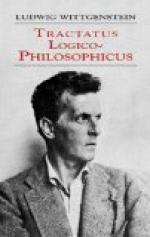6.2331 The process of calculating serves to bring about that intuition. Calculation is not an experiment.
6.234 Mathematics is a method of logic.
6.2341 It is the essential characteristic of mathematical method that it employs equations. For it is because of this method that every proposition of mathematics must go without saying.
6.24 The method by which mathematics arrives at its equations is the method of substitution. For equations express the substitutability of two expressions and, starting from a number of equations, we advance to new equations by substituting different expressions in accordance with the equations.
6.241 Thus the proof of the proposition 2 t 2 = 4 runs as follows: (v)n’x = v x u’x Def., 2 x 2’x = (2)2’x = (2)1 + 1’x = 2’ 2’x = 1 + 1’1 + 1’x = (’/)’(’)’x =/’’’’x = 1 + 1 + 1 + 1’x = 4’x. 6.3 The exploration of logic means the exploration of everything that is subject to law . And outside logic everything is accidental.
6.31 The so-called law of induction cannot possibly be a law of logic, since it is obviously a proposition with sense.—–Nor, therefore, can it be an a priori law.
6.32 The law of causality is not a law but the form of a law.
6.321 ’Law of causality’—that is a general name. And just as in mechanics, for example, there are ‘minimum-principles’, such as the law of least action, so too in physics there are causal laws, laws of the causal form.
6.3211 Indeed people even surmised that there must be a ’law of least action’ before they knew exactly how it went. (Here, as always, what is certain a priori proves to be something purely logical.)
6.33 We do not have an a priori belief in a law of conservation, but rather a priori knowledge of the possibility of a logical form.
6.34 All such propositions, including the principle of sufficient reason, tile laws of continuity in nature and of least effort in nature, etc. etc.— all these are a priori insights about the forms in which the propositions of science can be cast.
6.341 Newtonian mechanics, for example, imposes a unified form on the description of the world. Let us imagine a white surface with irregular black spots on it. We then say that whatever kind of picture these make, I can always approximate as closely as I wish to the description of it by covering the surface with a sufficiently fine square mesh, and then saying of every square whether it is black or white. In this way I shall have imposed a unified form on the description of the surface. The form is optional, since I could have achieved the same result by using a net with a triangular or hexagonal mesh. Possibly the use of a triangular mesh would have made the description simpler: that is to say, it might be that we could describe the surface more accurately with a coarse triangular mesh than with a fine square mesh (or conversely),




